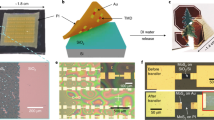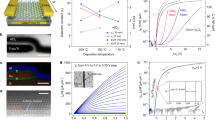Abstract
Atomically thin molybdenum disulfide (MoS2) is a promising semiconductor material for integrated flexible electronics due to its excellent mechanical, optical and electronic properties. However, the fabrication of large-scale MoS2-based flexible integrated circuits with high device density and performance remains a challenge. Here, we report the fabrication of transparent MoS2-based transistors and logic circuits on flexible substrates using four-inch wafer-scale MoS2 monolayers. Our approach uses a modified chemical vapour deposition process to grow wafer-scale monolayers with large grain sizes and gold/titanium/gold electrodes to create a contact resistance as low as 2.9 kΩ μm−1. The field-effect transistors are fabricated with a high device density (1,518 transistors per cm2) and yield (97%), and exhibit high on/off ratios (1010), current densities (~35 μA μm−1), mobilities (~55 cm2 V−1 s−1) and flexibility. We also use the approach to create various flexible integrated logic circuits: inverters, NOR gates, NAND gates, AND gates, static random access memories and five-stage ring oscillators.
This is a preview of subscription content, access via your institution
Access options
Access Nature and 54 other Nature Portfolio journals
Get Nature+, our best-value online-access subscription
$29.99 / 30 days
cancel any time
Subscribe to this journal
Receive 12 digital issues and online access to articles
$119.00 per year
only $9.92 per issue
Buy this article
- Purchase on Springer Link
- Instant access to full article PDF
Prices may be subject to local taxes which are calculated during checkout




Similar content being viewed by others
Data availability
The data that support the plots within this paper and other findings of this study are available from the corresponding author upon reasonable request.
References
Rus, D. & Tolley, M. T. Design, fabrication and control of soft robots. Nature 521, 467–475 (2015).
Wehner, M. et al. An integrated design and fabrication strategy for entirely soft, autonomous robots. Nature 536, 451–455 (2016).
Wang, S. et al. Skin electronics from scalable fabrication of an intrinsically stretchable transistor array. Nature 555, 83–88 (2018).
Gao, W. et al. Fully integrated wearable sensor arrays for multiplexed in situ perspiration analysis. Nature 529, 509–514 (2016).
Park, Y. J. et al. All MoS2-based large area, skin-attachable active-matrix tactile sensor. ACS Nano 13, 3023–3030 (2019).
Hosseini, P., Wright, C. D. & Bhaskaran, H. An optoelectronic framework enabled by low-dimensional phase-change films. Nature 511, 206–211 (2014).
Zhang, X. et al. Two-dimensional MoS2-enabled flexible rectenna for Wi-Fi-band wireless energy harvesting. Nature 566, 368–372 (2019).
Briseno, A. L. et al. Patterning organic single-crystal transistor arrays. Nature 444, 913–917 (2006).
Nomura, K. et al. Room-temperature fabrication of transparent flexible thin-film transistors using amorphous oxide semiconductors. Nature 432, 488–492 (2004).
Takei, K. et al. Nanowire active-matrix circuitry for low-voltage macroscale artificial skin. Nat. Mater. 9, 821–826 (2010).
Cao, Q. et al. Medium-scale carbon nanotube thin-film integrated circuits on flexible plastic substrates. Nature 454, 495–500 (2008).
Gelinck, G. H. et al. Flexible active-matrix displays and shift registers based on solution-processed organic transistors. Nat. Mater. 3, 106–110 (2004).
Kaltenbrunner, M. et al. An ultra-lightweight design for imperceptible plastic electronics. Nature 499, 458–463 (2013).
Min, S. Y. et al. Large-scale organic nanowire lithography and electronics. Nat. Commun. 4, 1773 (2013).
Khim, D. et al. Precisely controlled ultrathin conjugated polymer films for large area transparent transistors and highly sensitive chemical sensors. Adv. Mater. 28, 2752–2759 (2016).
Duan, S. et al. Scalable fabrication of highly crystalline organic semiconductor thin film by channel-restricted screen printing toward the low-cost fabrication of high-performance transistor arrays. Adv. Mater. 31, 1807975 (2019).
Xu, J. et al. Multi-scale ordering in highly stretchable polymer semiconducting films. Nat. Mater. 18, 594–601 (2019).
Nela, L., Tang, J., Cao, Q., Tulevski, G. & Han, S. J. Large-area high-performance flexible pressure sensor with carbon nanotube active matrix for electronic skin. Nano Lett. 18, 2054–2059 (2018).
Cao, X. et al. Fully screen-printed, large-area and flexible active-matrix electrochromic displays using carbon nanotube thin-film transistors. ACS Nano 10, 9816–9822 (2016).
Choi, Y. et al. Capacitively coupled hybrid ion gel and carbon nanotube thin-film transistors for low voltage flexible logic circuits. Adv. Funct. Mater. 28, 1802610 (2018).
Tang, J. et al. Flexible CMOS integrated circuits based on carbon nanotubes with sub-10-ns stage delays. Nat. Electron. 1, 191–196 (2018).
Liu, X., Long, Y.-Z., Liao, L., Duan, X. & Fan, Z. J. A. N. Large-scale integration of semiconductor nanowires for high-performance flexible electronics. ACS Nano 6, 1888–1900 (2012).
Lin, Y. Y., Hsu, C. C., Tseng, M. H., Shyue, J. J. & Tsai, F. Y. Stable and high-performance flexible ZnO thin-film transistors by atomic layer deposition. ACS Appl. Mater. Interfaces 7, 22610–22617 (2015).
Song, K. et al. Fully flexible solution-deposited ZnO thin-film transistors. Adv. Mater. 22, 4308–4312 (2010).
Sheng, J., Lee, H. J., Oh, S. & Park, J. S. Flexible and high-performance amorphous indium zinc oxide thin-film transistor using low-temperature atomic layer deposition. ACS Appl. Mater. Interfaces 8, 33821–33828 (2016).
Yang, Z. et al. Wafer-scale synthesis of high-quality semiconducting two-dimensional layered InSe with broadband photoresponse. ACS Nano 11, 4225–4236 (2017).
Pu, J. et al. Highly flexible MoS2 thin-film transistors with ion gel dielectrics. Nano Lett. 12, 4013–4017 (2012).
Salvatore, G. A. et al. Fabrication and transfer of flexible few-layers MoS2 thin film transistors to any arbitrary substrate. ACS Nano 7, 8809–8815 (2013).
Sarkar, D. et al. MoS2 field-effect transistor for next-generation label-free biosensors. ACS Nano 8, 3992–4003 (2014).
Lim, Y. R. et al. Wafer-scale, homogeneous MoS2 layers on plastic substrates for flexible visible-light photodetectors. Adv. Mater. 28, 5025–5030 (2016).
Yu, H. et al. Wafer-scale growth and transfer of highly-oriented monolayer MoS2 continuous films. ACS Nano 11, 12001–12007 (2017).
Kang, K. et al. High-mobility three-atom-thick semiconducting films with wafer-scale homogeneity. Nature 520, 656–660 (2015).
Xu, H. et al. High performance wafer scale MoS2 transistors toward practical application. Small 14, 1803465 (2018).
Lin, Z. et al. Solution-processable 2D semiconductors for high-performance large-area electronics. Nature 562, 254–258 (2018).
Wang, Y. et al. Van der Waals contacts between three-dimensional metals and two-dimensional semiconductors. Nature 568, 70–74 (2019).
Radisavljevic, B., Radenovic, A., Brivio, J., Giacometti, V. & Kis, A. Single-layer MoS2 transistors. Nat. Nanotechnol. 6, 147–150 (2011).
Wang, H. et al. Integrated circuits based on bilayer MoS2 transistors. Nano Lett. 12, 4674–4680 (2012).
Cheng, R. et al. Few-layer molybdenum disulfide transistors and circuits for high-speed flexible electronics. Nat. Commun. 5, 5143 (2014).
Amani, M. et al. Flexible integrated circuits and multifunctional electronics based on single atomic layers of MoS2 and graphene. Nanotechnology 26, 115202 (2015).
Shinde, S. M. et al. Surface functionalization mediated direct transfer of molybdenum disulfide for large area flexible devices. Adv. Funct. Mater. 28, 1706231 (2018).
Zhang., J. et al. Scalable growth of high-quality polycrystalline MoS2 monolayers on SiO2 with tunable grain sizes. ACS Nano 8, 6024–6030 (2014).
Hills, G. et al. Modern microprocessor built from complementary carbon nanotube transistors. Nature 572, 595–602 (2019).
Allain, A., Kang, J., Banerjee, K. & Kis, A. Electrical contacts to two-dimensional semiconductors. Nat. Mater. 14, 1195–1205 (2015).
Liu, H., Neal, A. T. & Ye, P. D. Channel length scaling of MoS2 MOSFETs. ACS Nano 6, 8563–8569 (2012).
Das, S., Chen, H.-Y., Penumatcha, A. V. & Appenzeller, J. High performance multilayer MoS2 transistors with scandium contacts. Nano Lett. 13, 100–105 (2013).
Liu, W., Sarkar, D., Kang, J., Cao, W. & Banerjee, K. Impact of contact on the operation and performance of back-gated monolayer MoS2 field-effect transistors. ACS Nano 9, 7904–7912 (2015).
Cui, X. et al. Low-temperature ohmic contact to monolayer MoS2 by van der Waals bonded Co/h-BN electrodes. Nano Lett. 17, 4781–4786 (2017).
Li, N. et al. Atomic layer deposition of Al2O3 directly on 2D materials for high‐performance electronics. Adv. Mater. Interfaces 6, 1802055 (2019).
Conley, H. J. et al. Bandgap engineering of strained monolayer and bilayer MoS2. Nano Lett. 13, 3626–3630 (2013).
Palacios-Berraquero, C. et al. Large-scale quantum-emitter arrays in atomically thin semiconductors. Nat. Commun. 8, 15093 (2017).
Lee, G.-H. et al. Flexible and transparent MoS2 field-effect transistors on hexagonal boron nitride-graphene heterostructures. ACS Nano 7, 7931–7936 (2013).
Acknowledgements
This project was supported by the National Science Foundation of China (NSFC grant nos. 61734001, 11834017, 11574361 and 51572289), the Strategic Priority Research Program (B) of CAS (grant no. XDB30000000), the Key Research Program of Frontier Sciences of CAS (grant no. QYZDB-SSW-SLH004), the National Key R&D program of China (grant no. 2016YFA0300904) and the Youth Innovation Promotion Association CAS (grant no. 2018013).
Author information
Authors and Affiliations
Contributions
G.Z. supervised the project. Q.W. performed the growth of the 4-inch MoS2 wafers. N.L. fabricated the flexible devices with help from Z.W., H.Y., C.S., J. Zhao. and G.W. N.L. performed the electrical measurements with help from C.S. and X.L. N.L., Q.W., R.Y. and G.Z. analysed data. N.L., Q.W., C.S., R.Y. and G.Z. wrote the manuscript and all authors commented on the manuscript.
Corresponding authors
Ethics declarations
Competing interests
The authors declare no competing interests.
Additional information
Publisher’s note Springer Nature remains neutral with regard to jurisdictional claims in published maps and institutional affiliations.
Supplementary information
Supplementary Information
Supplementary Figs. 1–16, discussion, Table 1 and references 1–20.
Rights and permissions
About this article
Cite this article
Li, N., Wang, Q., Shen, C. et al. Large-scale flexible and transparent electronics based on monolayer molybdenum disulfide field-effect transistors. Nat Electron 3, 711–717 (2020). https://doi.org/10.1038/s41928-020-00475-8
Received:
Accepted:
Published:
Issue Date:
DOI: https://doi.org/10.1038/s41928-020-00475-8
This article is cited by
-
Homojunction-loaded inverters based on self-biased molybdenum disulfide transistors for sub-picowatt computing
Nature Electronics (2024)
-
Effect of Thickness and Thermal Treatment on the Electrical Performance of 2D MoS2 Monolayer and Multilayer Field-Effect Transistors
Journal of Electronic Materials (2024)
-
Epitaxy of wafer-scale single-crystal MoS2 monolayer via buffer layer control
Nature Communications (2024)
-
Epitaxial substitution of metal iodides for low-temperature growth of two-dimensional metal chalcogenides
Nature Nanotechnology (2023)
-
12-inch growth of uniform MoS2 monolayer for integrated circuit manufacture
Nature Materials (2023)



